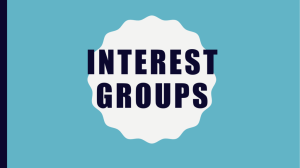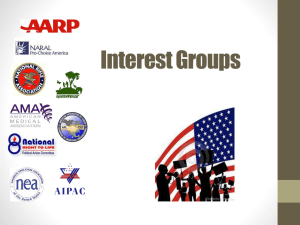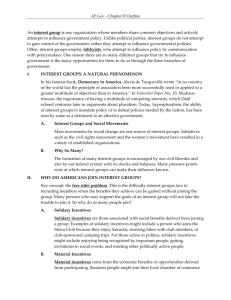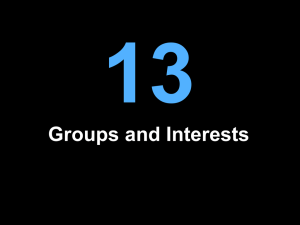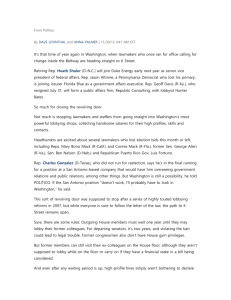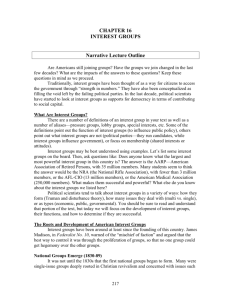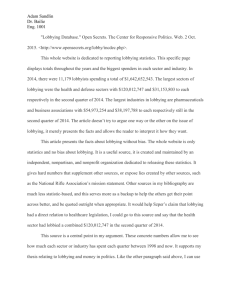chapter 8
advertisement
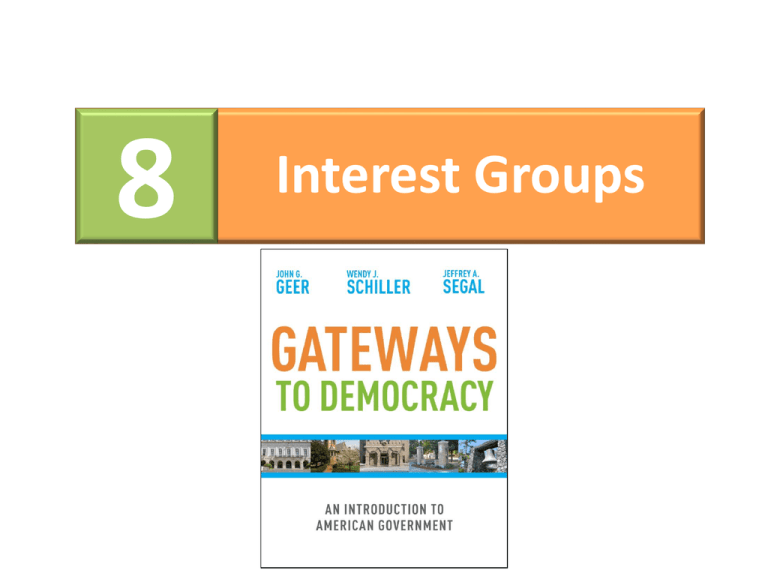
8 Interest Groups Interest Groups Interest groups are groups of citizens who share a common interest, whether a political opinion, religious affiliation, ideological belief, social goal, or economic objective, and that try to influence public policy to benefit their members. • Constitutionally, they are protected under the 1st Amendment’s right of freedom of association (right to assemble). • They are also the very factions that Madison warned about. Types of Interest Groups Most interest groups arise from conditions in public life. • A proactive group arises when an enterprising individual sees an opening or opportunity to create the group for social, political, or economic purposes. • A reactive group forms to protect the interests of the members in response to a perceived threat from another group, or to fight a government policy they believe will adversely affect them, or to respond to an unexpected external event. The Right of Petition Interest groups do not exist in a void. The form for the specific purpose of influencing public policy. • The right of petition gives individuals with a claim against the government the right to ask for compensation, but it also includes the right to petition to ask for a policy change or to express opposition to a policy. Lobbying Today, the rights of association and petition most often take the form of lobbying. • Trying to persuade elected officials to adopt or reject a specific policy change. • Lobbying is a legitimate form of petitioning, and interest groups of all sizes and purposes engage in it. How Does Lobbying Work? Interest groups lobby the legislative, executive, and even judicial branches of government, at the state and federal levels. • Meet with staff aides to members of Congress to make the case for their policy goals. • Try to influence the executive branch by meeting personally with key bureaucrats and policy makers. • Lobbying of the judicial branch takes the form of lawsuits against government policies that interest groups see as fundamentally unconstitutional or that go against the original intent of a law. The History of Interest Groups Abolition • American Anti-Slavery Society in 1833 Women’s rights • National Woman Suffrage Association in 1869 Trade Associations • National Association of Wool Manufacturers in 1864 The History of Interest Groups Abolitionists used stark imagery and words to rally citizens against slavery. In 1843 Lydia Maria Child compiled The American Anti-Slavery Almanac. Its cover alone makes the case for abolition. Child was a writer and editor who was also active in the women’s suffrage movement. The History of Interest Groups continued Veteran’s rights • The Grand Army of the Republic in 1866 Prohibition • Anti-Saloon League of America in 1895 Labor Organizations • International Ladies’ Garment Workers’ Union in 1900 – Triangle Shirtwaist Factory Fire Interest Groups Today Today, business and trade associations, unions, citizens’ organizations, and grassroots movements are a familiar part of the landscape of interest group politics. • Business and Trade – The Chamber of Congress • Unions – American Federation of Labor-Congress of Industrial Organizations (AFL-CIO) • Citizen’s Organizations – National Rifle Association (NRA) • Grassroots Movements – Greenpeace Interest Groups Today – Union Membership Economic Interest Groups Economic interest groups form to advance the economic status of their members and are defined by a specific set of financial or business concerns. • Trade associations are a subcategory of economic interest groups that focus on particular businesses or industries. – Chamber of Commerce • Professional associations are similar, as they are formed by individuals who share a similar job. – American Bar Association Economic Interest Groups continued • Large corporations can be included as a type of economic interest group, because they try to influence policy on their own as well as joining trade associations comprised of businesses with similar goals. – Wal-Mart Economic Interest Groups continued • Unions are a type of economic interest group. They are comprised of people who share a common type of employment. Unions seek safer working conditions and better wages for their members. - Collective bargaining is protected by the National Labor Relations Act, passed by Congress in 1935. - The act provides that only one union can be selected to represent workers in a specific location - Power rests in the ability to call strikes or work stoppages. - Power to mobilize members to vote for or against a candidate. Ideological Interest Groups Ideological interest groups form among citizens with the same beliefs about a specific issue. • Citizens’ Groups – Citizens groups are typically formed to draw attention to public issues that affect all citizens equally, such as environmental protection, transparency in government, consumer product safety, ethics reform, and campaign finance reform. Ideological Interest Groups continued • Single-issue groups form to present one view on a highly salient issue that is intensely important to its members, such as the right to carry a concealed weapon is to Students for Concealed Carry on Campus. • Grassroots groups form in response to an economic or political event, but do not focus on only one issue. Ideological Groups and Polarization • Because ideological groups get power from the fact that they have agreement within their ranks on a highly salient issue, it discourages debate and disagreement within the group and any type of compromise outside the group. This leads to polarization between ideologically opposed groups. – Polarization is the condition in which differences between parties and/or the public are so stark that disagreement breaks out, fueling attacks and controversy. Foreign Policy Groups Foreign policy groups form to generate support for favorable U.S. policies toward one or several foreign countries. • American Israel Public Affairs Committee (AIPAC) • Coalition to Save Darfur The Coalition to Save Darfur The Coalition to Save Darfur is an interest group that mobilizes people to email, call, or send letters to their legislators on behalf of its effort to end violence and famine in the Darfur region of the African nation of Somalia. In 2006 thousands joined a grassroots rally in New York City to express their support for sending United Nations troops to Darfur to help stop the violence there. What Interest Groups Do Interest groups perform a number of functions in the political process. • Inform - All interest groups provide information to their members, the media, government officials, and the general public. • Interpret - Interest groups do more than merely report on current policy developments; they also provide members and the government with an interpretation of how these developments will affect the group’s mission and goals. What Interest Groups Do continued • Lobby – Almost every kind of group, with every kind of economic interest or political opinion, engages in one form of lobbying or another. – Lobbyists • According to the Center for Responsive Politics, in 2009 there were 13,739 individuals registered as active lobbyists in Washington, D.C. • Phone, e-mail, or meet with congressional staffers, their clients, and possibly members of the media to gather information about relevant issues for their clients or to promote their clients’ policy positions. Top Spenders on Lobbying What Interest Groups Do continued • Lobbying Strategies - Inside Lobbying is where lobbyists deal directly with legislators and their staff in asking for a specific policy benefit or in trying to stop a policy that they oppose. - Public or Outside Lobbying is where a group may go straight to the press to provide details about the adverse effects of the proposal, in the hopes that journalists will then inform the general public. - Grassroots Lobbying is where groups encourage an action among their own members and the larger public to try to influence public policy. What Interest Groups Do continued • Campaign Activities – Interest groups also promote their views by engaging in campaign activities, though federal law regulates their participation. – 501(c)(3) Groups have a tax-exempt status and are prohibited from engaging in any activity on behalf of a candidate or party in an election campaign. – Political Action Committees raise funds to support electoral candidates and are subject to campaign finance laws. – Issue Advocacy is the practice of running advertisements or distributing literature on a policy issue rather than a specific candidate. Top Twenty PAC Contributors The Impact of Interest Groups on the Democratic Process Do interest groups provide a natural balance or do they create disproportionate power? • Robert Dahl argued that in a pluralist society, the varied interest groups that emerge to represent their members will, in their battles over public policy, produce a consensus that serves the public’s common interest. – Pluralist is a view of democratic society in which interest groups compete over policy goals and elected officials are mediators of group conflict. The Impact of Interest Groups continued • Theodore Lowi argued that in a democracy some voices are louder than others and that government is more responsive to louder voices and will consistently serve those groups at the expense of those who cannot make their voices heard. – Elitist is a view of democratic society in which only a select few interest groups shape policies in favor of a small group of wealthy or powerful citizens. – Special Interests are a set of groups seeking a particular benefit for themselves in the policy process. Interest Groups as a Threat to Democracy In his Farewell Address in 1961, President Dwight D. Eisenhower (1953–61) warned of what he called the military-industrial complex. • A self-serving interconnection among the U.S. military, the defense manufacturing industry, and federal agencies overseeing military expenditures and production. – Iron Triangle describes the insular and closed relationship among interest groups, members of Congress, and federal agencies. – Revolving Door describes the movement of members of Congress, lobbyists, and executive branch employees into paid positions in each other’s organizations. Interest Groups as a Threat to Democracy – Iron Triangle Issue Networks Interest group scholar Hugh Heclo claims that the interconnections of interest groups and the government is more benign, suggesting that the term “issue networks” is better than “iron triangle” to describes the relationship. • View of the relationship among interest groups, members of Congress, and federal agencies as more fluid, open, and transparent than the term “iron triangle.” • Congress and the federal bureaucracy each have an elaborate set of rules governing their behavior with respect to interest groups and lobbyists, and most members and bureaucrats follow them closely. Characteristics of Successful Interest Groups Leadership Accountability • Transparency • Membership feedback Membership Stability • Whether a group is small or large, attracting and keeping members over time are essential to its survival. – Selective benefits – Solidarity Benefits – Expressive Benefits Successful Interest Groups continued – The Free Rider Problem » Many of the benefits that large interest groups seek on behalf of their members—clean air by the Sierra Club, or gun rights by the National Rifle Association—are public goods. That is, they are available to all. - Tangible Benefits - Economic and Political Changes Financial Stability • Membership dues • Not for profit status – Donations Interest Groups and Public Policy Immigration • Interest groups align along both sides of the debate. – Proponents of amnesty argue that bringing illegal residents into legal society would make it possible for them to earn fair wages, participate in politics, and pay taxes on their earnings. • National Council of La Raza – Opponents of immigration reform argue that the previous amnesty program has only encouraged more people to enter the United States illegally and that illegal immigrants take away jobs from the legal resident population. • NumbersUSA Interest Groups and Public Policy Through the use of mass media and advanced technology, groups can organize protest marches on a much larger scale than ever before. On March 21, 2010, Reform America staged a huge march on the National Mall in Washington, D.C., calling for immigration reform that includes a secure border strategy, expansion of the number of legal immigration visas, and amnesty for illegal immigrants currently in the United States. Focus Questions • How do interest groups influence economic and social policy? • How do interest groups help or hinder government responsiveness to all citizens in an equal and fair way? • Are interest groups themselves democratic organizations? Are their leaders accountable to their members? Explain. • Do interest groups balance each other out, across income levels, regions, and ethnic backgrounds? Explain and give examples. • Are interest groups gates, or gateways, to democracy?


